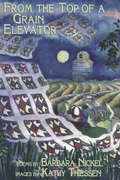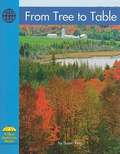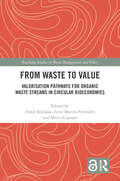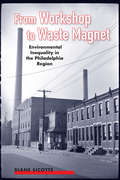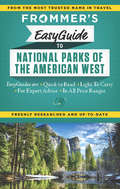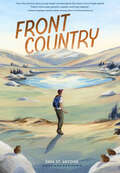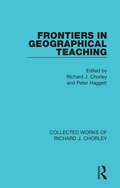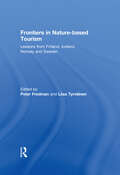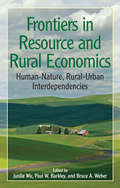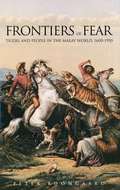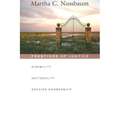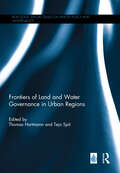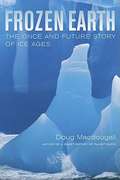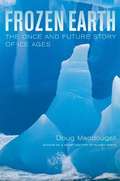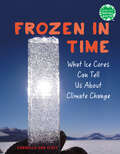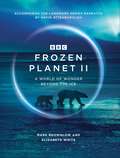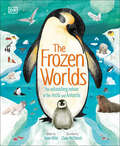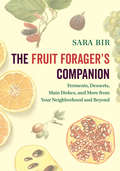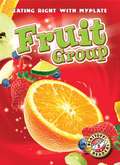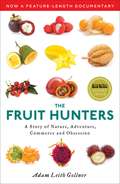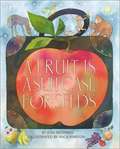- Table View
- List View
From the Top of a Grain Elevator
by Barbara NickelShort-listed for the 1999 CLA Book of the Year for Children Award Award-winning poet and playwright Barbara Nickel returns to her Prairie roots in a beautiful collection of seasonal poems that chart, with a bird’s-eye view of the western landscape, nature’s glorious playground. Nickel’s experimental verses are perfectly complimented by Kathy Thiessen’s black-and-white etchings, making this ideal for any young Canadian – Prairie-dweller, would-be poet, or otherwise.
From Tree to Table
by Susan RingThis book reviews the process of gathering, making, and selling maple syrup.
From Waste to Value: Valorisation Pathways for Organic Waste Streams in Circular Bioeconomies (Routledge Studies in Waste Management and Policy)
by Antje Klitkou Arne Martin Fevolden Marco CapassoFrom Waste to Value investigates how streams of organic waste and residues can be transformed into valuable products, to foster a transition towards a sustainable and circular bioeconomy. The studies are carried out within a cross-disciplinary framework, drawing on a diverse set of theoretical approaches and defining different valorisation pathways. Organic waste streams from households and industry are becoming a valuable resource in today’s economies. Substances that have long represented a cost to companies and a burden for society are now becoming an asset. Waste products, such as leftover food, forest residues and animal carcasses, can be turned into valuable products such as biomaterials, biochemicals and biopharmaceuticals. Exploiting these waste resources is challenging, however. It requires that companies develop new technologies and that public authorities introduce new regulation and governance models. This book helps policy-makers govern and regulate bio-based industries, and helps industry actors to identify and exploit new opportunities in the circular bioeconomy. Moreover, it provides important insights for all students and scholars concerned with renewable energy, sustainable development and climate change.
From Workshop to Waste Magnet: Environmental Inequality in the Philadelphia Region
by Diane SicotteLike many industrialized regions, the Philadelphia metro area contains pockets of environmental degradation: neighborhoods littered with abandoned waste sites, polluting factories, and smoke-belching incinerators. However, other neighborhoods within and around the city are relatively pristine. This eye-opening book reveals that such environmental inequalities did not occur by chance, but were instead the result of specific policy decisions that served to exacerbate endemic classism and racism. From Workshop to Waste Magnet presents Philadelphia's environmental history as a bracing case study in mismanagement and injustice. Sociologist Diane Sicotte digs deep into the city's past as a titan of American manufacturing to trace how only a few communities came to host nearly all of the area's polluting and waste disposal land uses. By examining the complex interactions among economic decline, federal regulations, local politics, and shifting ethnic demographics, she not only dissects what went wrong in Philadelphia but also identifies lessons for environmental justice activism today. Sicotte's research tallies both the environmental and social costs of industrial pollution, exposing the devastation that occurs when mass quantities of society's wastes mix with toxic levels of systemic racism and economic inequality. From Workshop to Waste Magnet is a compelling read for anyone concerned with the health of America's cities and the people who live in them.
Frommer's EasyGuide to National Parks of the American West
by Don Laine Eric PetersonQuick to read, light to carry with expert advice in all price ranges, Frommer's EasyGuide to National Parks of the American West is the complete up-to-date reference for travelers who want to maximize their visit in the smartest, most time-efficient way. Frommer's trademark candid and accessible expertise offers reviews on selecting the correct park for you based on interests and length of stay, complete with suggested driving tours. The guide also covers where to find the best hiking trails, rafting, rock climbing, wildlife viewing, scenery and campgrounds. Insightful commentary on everything from the natural attractions to avoiding crowds and finding the best times to visit, as well as finding the right place to stay.
Front Country
by Sara St. Antoine"This is a story about the ache and promise of our world, and it begs us to pay attention to both. A terrific and important read."―Gary D. Schmidt, Newbery Honoree, Printz Honoree, and National Book Award Finalist for Okay for Now "Give this novel to every young reader worried about the future of our fragile planet."―Katherine Applegate, Newbery Medal–winning and #1 New York Times bestselling author of The One and Only Ivan My Side of the Mountain meets Greta Thunberg in this heartfelt, exciting novel about one girl’s growing awareness of herself, the world, and the relationship between the two. The world is not okay. Now what?Ginny Shepard is glad to be in Montana for a month of backcountry camping before she starts high school. The world is on fire. That's the awful truth. And Ginny would much rather be hiking in the mountains than doing the summer college prep classes her parents think will help her future. Because, the future? Who even knows what that is anymore.But once Ginny gets to camp, things get complicated fast. She meets her tripmates: five challenging, rebellious, tech-addicted boys. And she finds out TrackFinders is designed for kids who need extra "support." Instead of feeling free as a bird, Ginny feels trapped . . . and betrayed.As her friendships with her fellow campers deepen on the trail, though, Ginny starts to see new sides of them—and of herself. Maybe out here in the backcountry she'll actually find what she needs to face the front country again.Set in Montana's sweeping alpine wilderness, this epic adventure captures the tremendous heartbreak of realizing the world isn't okay at all and shows how that knowledge, and what we choose to do with it, shapes us into who we are. AN EMPOWERING ADVENTURE STORY: Despite humans' ever-worsening impact on the environment, there are relatively few books about the topic—especially for young readers, and especially that don't feel preachy. This book is an empowering adventure story, and it's also positive, not depressing.STRONG FEMALE PROTAGONIST: Ginny positively models dealing with strengths and weaknesses to readers, who are full of flaws but full of strengths, too. The way she struggles with both will speak to young readers. Even kids who are not interested in climate change will recognize her as a fellow young person and quickly become aware of the ways she's able to effect change—and the ways she still can't.STEM TOPICS: Educators and librarians will love tying this fictional story to nonfiction curriculum, and there are several different access points for this book from a scientific perspective. Environmental science, earth science, climate change, differing regional biomes, geology, and biology are all explored in real-world, character-driven ways.GIRLS IN SCIENCE: Ginny's passion for science shows readers that science-loving girls can be cool—and there are many different ways characters of all genders embrace science.A THRILLING PAGE-TURNER: In the tradition of Hatchet and Wolf Hollow, this book is an excellent, fast-paced story that's impossible to put down. Kids will love every character—or love to hate them—and will finish the book feeling like they're leaving friends behind. Perfect for:Animal loversKids who love adventure and natureTeachers and librarians
Frontiers in Geographical Teaching (Collected Works of Richard J. Chorley)
by Richard J. Chorley Peter HaggettOriginally published in 1965 and with a second edition in 1970. Building upon the original two Madingley Hall seminars for teachers of non-university geography in 1965, this book presents an updated research picture of the 1970 transatlantic perspective. Answering the questions "What is happening in geography" and "What impact does this have on school geography", this provided a real link for students who were then making the increasingly difficult transition from school to university geography. Originally receiving a hostile reaction from British journals, the book’s diagnosis and prognosis were a forerunner of developments in methodological changes of the discipline. This work collects a series of essays delineating geographic concepts in terms of the philosophic underpinnings, assessment of the geomorphic system, climatology, and social economic and historical changing trends. Techniques are reviewed including quantitative methods for geomorphology and social geography, fieldwork both in urban areas and land-use surveys, and finally in physical planning. Final analyses examine and contrast the teaching methods and courses in American and British High Schools, Colleges and Universities.
Frontiers in Nature-based Tourism: Lessons from Finland, Iceland, Norway and Sweden
by Peter Fredman Liisa TyrväinenNature has been a key attraction factor for tourism in the Nordic countries for decades. The demand for nature-based tourism has steadily grown and is one of the most rapidly expanding sectors within tourism across Europe and elsewhere. This demand has created opportunities for nature-based tourism to develop as an economic diversification tool within regions rich in natural amenities. But nature-based tourism is not only about tourism businesses and tourists visiting nature. The natural environment as a basis for tourism involves many challenges related to local communities, public access, nature protection and the management of natural resources.This book covers a broad set of topics in contemporary nature-based tourism from Finland, Iceland, Norway and Sweden. Areas discussed are innovation, fishing rights and supply of angling, recreation experience preferences, national park attractions, the cultural clash between established outdoor recreational use and new tourism activities, the Right of Public Access as opportunity and obstacle, preferences of tourism landscapes, controversies around wilderness development, management of hiking trails, eco-tourism certification, and financing of recreational infrastructure.This book was published as a special issue of the Scandinavian Journal of Hospitality and Tourism.
Frontiers in Resource and Rural Economics: "Human-Nature, Rural-Urban Interdependencies"
by Wu JunJie Paul W Barkley Bruce A WeberMost land in the United States is in rural areas, as are the sources of most of its fresh water and almost all its other natural resources. One of the first books to approach resource economics and rural studies as fundamentally interconnected areas of study, Frontiers in Resource and Rural Economics integrates the work of 18 leading scholars in resource economics, rural economics, rural sociology and political science in order to focus on two complex interdependencies-one pertaining to natural resources and human welfare, the other to urban and rural communities and their economies. The book reviews the past 50 years of scholarship in both natural resource and rural economics. It contrasts their different intellectual and practical approaches and considers how they might be refocused in light of pressing demands on human and natural systems. It then proposes a 'new rural economics' that acknowledges the full range of human-ecosystem and urban-rural interdependencies. It explores the relationship between natural resources and economic growth, and considers the prospects for amenity-driven growth that would benefit both new and traditional inhabitants of rural areas. Later chapters explore the politics of place, spatial economics, strategies for reducing rural poverty, and prospects for linking rural and environmental governance. Throughout, the book emphasizes innovative research methods that integrate natural resource, environmental, and rural economics.
Frontiers of Fear: Tigers and People in the Malay World, 1600-1950
by Peter BoomgaardThis book is about the relation between humans and the three big cats of the Malay world: the tiger, the leopard, and the clouded leopard. Above all, however, it is about the tiger.It is difficult to be neutral about tigers. They seem to elicit either strongly positive or strongly negative sentiments, and it is even possible (and far from rare) that one person has both positive and negative feelings about tigers.
Frontiers of Justice: Disability, Nationality, Species Membership
by Martha C. Nussbaumgeneral and the timeless. Yet such theories, addressing the world and its problems, must respond to the real and changing dilemmas of the day. A brilliant work of practical philosophy, Frontiers of Justice is dedicated to this proposition. Taking up three urgent problems of social justice neglected by current theories and thus harder to tackle in practical terms and everyday life, Martha Nussbaum seeks a theory of social justice that can guide us to a richer, more responsive approach to social cooperation.<P><P> The idea of the social contract--especially as developed in the work of John Rawls--is one of the most powerful approaches to social justice in the Western tradition. But as Nussbaum demonstrates, even Rawls's theory, suggesting a contract for mutual advantage among approximate equals, cannot address questions of social justice posed by unequal parties. How, for instance, can we extend the equal rights of citizenship--education, health care, political rights and liberties--to those with physical and mental disabilities? How can we extend justice and dignified life conditions to all citizens of the world? And how, finally, can we bring our treatment of nonhuman animals into our notions of social justice? Exploring the limitations of the social contract in these three areas, Nussbaum devises an alternative theory based on the idea of "capabilities." She helps us to think more clearly about the purposes of political cooperation and the nature of political principles--and to look to a future of greater justice for all.
Frontiers of Land and Water Governance in Urban Areas (Routledge Special Issues on Water Policy and Governance)
by Thomas Hartmann and Tejo SpitA society that intensifies and expands the use of land and water in urban areas needs to search for solutions to manage the frontiers between these two essential elements for urban living. Sustainable governance of land and water is one of the major challenges of our times. Managing retention areas for floods and droughts, designing resilient urban waterfronts, implementing floating homes, or managing wastewater in shrinking cities are just a few examples where spatial planning steps into the governance arena of water management and vice versa. However, water management and spatial planning pursue different modes of governance, and therefore the frontiers between the two disciplines require developing approaches for setting up governance schemes for sustainable cities of the future. What are the particularities of the governance of land and water? What is the role of regional and local spatial planning? What institutional barriers may arise? This book focuses on questions such as these, and covers groundwater governance, water supply and wastewater treatment, urban riverscapes, urban flooding, flood risk management, and concepts of resilience. The project resulted from a Summer School by the German Academy for Spatial Research and Planning (ARL) organized by the editors at Utrecht University in 2013.This book was published as a special issue of Water International.
Frosty: A Raccoon to Remember
by Harriet E. WeaverIn this warm and joyous book, Harriet E. Weaver, for 20 years the only lady ranger in California’s Big Basin Redwood Park, tells the story of life with an orphan raccoon named Frosty, an impish, intelligent and irresistibly charming creature of the wilds. Appropriate for children, but enjoyable by all ages...
Frozen Adventures: Looking at Glaciers Around the World (Fountas & Pinnell Classroom, Guided Reading Grade 6)
by M. E. ReidNIMAC-sourced textbook
Frozen Earth: The Once and Future Story of Ice Ages
by Doug MacdougallIn this engrossing and accessible book, Doug Macdougall explores the causes and effects of ice ages that have gripped our planet throughout its history, from the earliest known glaciation--nearly three billion years ago--to the present. Following the development of scientific ideas about these dramatic events, Macdougall traces the lives of many of the brilliant and intriguing characters who have contributed to the evolving understanding of how ice ages come about. As it explains how the great Pleistocene Ice Age has shaped the earth's landscape and influenced the course of human evolution, Frozen Earth also provides a fascinating look at how science is done, how the excitement of discovery drives scientists to explore and investigate, and how timing and chance play a part in the acceptance of new scientific ideas. Macdougall describes the awesome power of cataclysmic floods that marked the melting of the glaciers of the Pleistocene Ice Age. He probes the chilling evidence for "Snowball Earth," an episode far back in the earth's past that may have seen our planet encased in ice from pole to pole. He discusses the accumulating evidence from deep-sea sediment cores, as well as ice cores from Greenland and the Antarctic, that suggests fast-changing ice age climates may have directly impacted the evolution of our species and the course of human migration and civilization. Frozen Earth also chronicles how the concept of the ice age has gripped the imagination of scientists for almost two centuries. It offers an absorbing consideration of how current studies of Pleistocene climate may help us understand earth's future climate changes, including the question of when the next glacial interval will occur.
Frozen Earth: The Once and Future Story of Ice Ages
by Douglas MacdougallDoug Macdougall explores the causes and effects of ice ages that have gripped our planet throughout its history, from the earliest known glaciations -- nearly three billion years ago -- to the present.
Frozen Earth: The Once and Future Story of Ice Ages
by Douglas MacdougallAn accessible account of the nature and global effects of Ice Ages, including the history of how several maverick scientists developed various pieces of our current scientific theory of these times, and how recent studies of Pleistocene climate may help us understand Earth's future climate changes.
Frozen in Time: What Ice Cores Can Tell Us About Climate Change (Books for a Better Earth)
by Carmella Van VleetA dazzling introduction to paleoclimatology for kids, connecting the methods that scientists use to study our climate history with future climate change solutions.Believe it or not, ice isn&’t always just frozen water. In fact, most of the ice covering our planet contains thousands of years' worth of information about our atmosphere. This ice is made up of a lot more than snow—it has soot, volcanic ash, gasses, and other substances that affect the climate. And if we drill a piece of that ice? We get a frozen time capsule, courtesy of Earth. In this exhilarating middle grade nonfiction book by a former educator, kids are immersed in the field of paleoclimatology. Readers go along on an ice core expedition, run through each step in the collecting and transporting process, review the fascinating components of an ice core, and explore the specialized labs where scientists examine them.But these pieces of our planet are more than just cool records. By preserving and studying these frosty collections of climate history, we can learn from previous patterns and better protect our planet in the future. The final chapter focuses on ice as a key tool in the fight against climate change.With crystal-clear explanations and an engaging, kid friendly tone, the book features 15+ full-color photographs, diagrams, interviews with paleoclimatologists, a glossary of terms, and simple experiments for budding scientists at home. Books for a Better Earth are designed to inspire children to become active, knowledgeable participants in caring for the planet they live on.A Junior Library Guild Gold Standard Selection
Frozen Planet II
by Mark Brownlow Elizabeth WhiteACCOMPANIES THE LANDMARK SERIES NARRATED BY DAVID ATTENBOROUGHFind a world of wonder beyond the ice. 'Looking down at our planet from space it may come as a surprise how much of it is blanketed in snow and ice. These vast frozen wildernesses cover more than a fifth of the earth ... From the highest peaks to snow-bound deserts to alien worlds deep beneath the ice, they are home to an astonishing array of animals found nowhere else on earth.'David Attenborough, from the series.Frozen Planet II celebrates the surprisingly diverse worlds of ice - a world that is disappearing before our very eyes. Previously undiscovered stories, from chameleons giving birth on the frosty slopes of Mount Kenya to endangered Amur leopards in the Russian forest and killer whales hunting Weddell seals on ice floes in the Antarctic, shed new light on the beauty and the peril of the world's most fragile ecosystems. Behind-the-scenes insights explore the unique challenges of filming in these frozen worlds, where camera crew and wildlife alike brave the extreme conditions.With over 250 stunning full-colour photographs, Frozen Planet II reveals the wonders of the fastest-changing part of our planet, as we may never see them again.
The Frozen Worlds: The Astonishing Nature of the Arctic and Antarctic (The Magic and Mystery of the Natural World)
by Jason BittelEnter the world of the Arctic and Antarctic, in this gorgeously illustrated book for young animal and conservation enthusiasts.Polar bears and penguins glide and whales and walruses dive across the pages of this colorful book, which takes children on a fascinating sub-zero journey of the amazing Earth&’s poles.The Frozen Worlds combines stunning illustrations and photos to help young enthusiasts aged 7-9 learn all about the Arctic and Antarctic. From incredible frozen rivers to Antarctic volcanoes, they&’ll discover the incredible secret life of Earth&’s polar regions, as well as which plants and animals live near them, and how they can protect them from the issues facing them today. Children will love finding out all about the different people who live and work here, and how they can help take care of the Arctic and Antarctic themselves.This fascinating book for children features: - Intriguing information about the Arctic and Antarctic, that supports and goes beyond the curriculum!- Factual, fascinating, and fun content - with detailed illustrations and photographs of animals, icebergs, and more.- An engaging mixture of stunning photography and detailed illustrations by Claire McElfatrick.- Exciting and unusual facts convey information about our amazing polar regions.The Frozen Worlds covers a wide range of exciting subjects about the polar regions, from their wildlife to their geography and history, including a multitude of polar life, amazing facts on how icebergs are formed, how animals survive in the freezing cold, and how scientists study the Antarctic. Children with an interest in the Earth&’s icy poles will love reading about the ecosystems, habitats and climates in these fascinating regions.
The Fruit Forager's Companion: Ferments, Desserts, Main Dishes, And More From Your Neighborhood And Beyond
by Sara BirFrom apples and oranges to pawpaws and persimmons Half of the fruit that grows in yards and public spaces is never picked or eaten. Citrus trees are burdened with misshapen lemons, berries grow in tangled thickets on the roadside, and the crooked rows of abandoned orchards fill with fallen apples. At the same time, people yearn for an emotional connection that’s lacking in bland grocery store bananas and tasteless melons. The Fruit Forager’s Companion is a how-to guide with nearly 100 recipes devoted to the secret, sweet bounty just outside our front doors and ripe for the taking, from familiar apples and oranges to lesser-known pawpaws and mayhaws. Sara Bir—a seasoned chef, gardener, and forager—primes readers on foraging basics, demonstrates gathering and preservation techniques, and presents a suite of recipes including habanero crabapple jelly, lime pickle, pawpaw lemon curd, and fermented cranberry relish. Bir encourages readers to reconnect with nature and believes once the foraging mindset takes control, a new culinary world hiding in plain sight will reveal itself. Written in a witty and welcoming style, The Fruit Forager’s Companion is a must-have for seekers of both flavor and fun.
Fruit Group
by Megan Borgert-SpaniolRelevant images match informative text in this introduction to the fruit group. Intended for students in kindergarten through third grade
The Fruit Hunters: A Story of Nature, Adventure, Commerce, and Obsession
by Adam Leith GollnerDelicious, lethal, hallucinogenic and medicinal, fruits have led nations to war, fueled dictatorships and lured people into new worlds. An expedition through the fascinating world of fruit, The Fruit Hunters is the engrossing story of some of Earth's most desired foods. In lustrous prose, Adam Leith Gollner draws readers into a Willy Wonka-like world with mangoes that taste like piña coladas, orange cloudberries, peanut butter fruits and the miracle fruit that turns everything sour to sweet, making lemons taste like lemonade. Peopled with a cast of characters as varied and bizarre as the fruit -- smugglers, inventors, explorers and epicures -- this extraordinary book unveils the mysterious universe of fruit, from the jungles of Borneo to the prized orchards of Florida's fruit hunters to American supermarkets. Gollner examines the fruits we eat and explains why we eat them (the scientific, economic and aesthetic reasons); traces the life of mass-produced fruits (how they are created, grown and marketed) and explores the underworld of fruits that are inaccessible, ignored and even forbidden in the Western world. An intrepid journalist and keen observer of nature -- both human and botanical -- Adam Leith Gollner has written a vivid tale of horticultural obsession.
A Fruit Is a Suitcase for Seeds
by Jean RichardsA description of seed dispersal by which plants, most specifically fruits, travel from one place to another.
